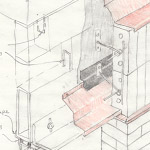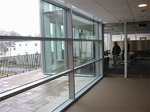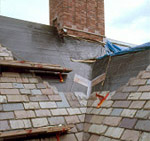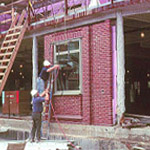Would you or your organization like to build awareness of building envelope and building technology issues? Leavitt Associates offers customized seminars and lunch talks tailored to your needs. Our seminar can be presented in a variety of formats, from a series of lunch talks, or as an all-day event. We also offer customized versions directed to the needs of specific groups such as project managers, contractors, or architects.
If you are interested in attending our seminar or having it presented to a group, please contact us for more information.
Example
Part 1: Masonry and Flashing Explained
(50 minutes including Q&A)

Proper flashing details are seldom illustrated fully in the office. This seminar illustrates how these flashings look in real life, and how to identify and solve problems in advance.
Ancient roots and modern practice – Did they ever really build them “like they used to”? Some interesting facts about masonry practice in the recent and distant past.
The hydrology of buildings – What goes on inside a masonry wall? Why do we always seem to recommend cavity walls today?
The art of flashing – Is a continuation of roofing by other means. We discuss flashing materials and where to use them; and show examples of details developed for real-life conditions.
Air barriers versus moisture barriers – Some myths and realities of the “building envelope” as understood today. A discussion of the benefits and features of common water-resistant materials.
Condensation in theory and reality – When is condensation something to be concerned about, and when is it not? We discuss occupancies such as residential, office, pool enclosures, greenhouse, and other humidified environments.
The causes of cracks in masonry – Is cracking inevitable, and when does it become a problem? The mechanisms of brick movement relative to structural movement. Discussion of brick ties, hardware, and other embedded items.
Back-up walls – Metal studs or masonry back-up? A discussion of the advantages and disadvantages of each system.
Deterioration and maintenance of walls – Efflorescence, its causes and cures; freeze-thaw damage and pointing.
Brick veneer and the cavity wall today – What do you look for in a properly constructed cavity wall?
Looking to save money? – Where should you look to save costs, and where should you not? Realistically understand the costs, benefits, and service life of masonry wall components.
Part 2: Low-Slope Roofing and Below-Grade Waterproofing
(50 minutes including Q&A)

The exterior plaza is flush with the interior carpet surface, and yet this building is very reliably protected against leakage from the plaza or the curtainwall. How was this achieved?
Staying out of trouble – Ten commandments of low-slope roofing
Watching your perimeter – Focus on common perimeter conditions in roofing and plaza waterproofing that cause problems
Plaza waterproofing – The ten commandments of roofing, as they apply to plaza waterproofing. The advantages and disadvantages of competing plaza waterproofing systems.
Danger areas – What are the common mistakes people make with building expansion joints, planters, handrails, and terminations?
Below-grade waterproofing concepts – What are the principles behind waterproofing and damp-proofing, membrane waterproofing, bentonite waterproofing, and other systems?
How much below-grade waterproofing protection is enough? We classify the perennial disagreements on this subject, and weigh in our opinions on how to choose between waterproofing systems on the market today.
Part 3 – Sloped Roofing and Shingle Construction
(50 minutes including Q&A)

This photograph shows a graduated slate roof under construction. But the key elements that will keep this roof from leaking are not visible in this photograph. Learn the ten most important issues to address with slate roofing.
Slate roofing – It lasts a lifetime with proper materials and construction practice. Learn the key features of monumental slate roofs and the common problem areas.
Ridge venting, eave venting, attic venting – When does it really matter and why is it in the code?
Flat seam metal roofing and wall panels – It has become popular in the last ten years. Why?
Architectural Metal Roofing – Or pre-manufactured standing seam roofing. With kit systems, it’s the special conditions where you have problems to solve.
Wood frame construction – The principles of shingle roofing applied to a vertical wall.
Exterior wood trim and bay windows – Why does paint peel, why do joints open up, why does wood cup, and why does wood rot?
Part 4: Windows and Curtainwalls
(50 minutes including Q&A)

Someone used sealant to cover over a crack in this stucco wall. Then, a new crack formed along the edge of the sealant! Find out why sealants aren’t always a good solution.
Window perimeters – The element that nobody guarantees is the one that fails most often. Find out why and learn how to avoid common mistakes.
Evaluating the tests – Windows receive performance ratings from manufacturers. What do the ratings really mean? We discuss misleading and valid measures of window performance.
Insulating glass units – How long will they really last? What do you look for in a good IGU?
Sealants – The best of materials and the worst of materials. Learn what problems sealant can do and what problems they cannot solve.
Part 5: Getting What You Paid For
(50 minutes including Q&A)

By the time this mock-up was installed and water-tested, the windows for this project had already been fabricated. Learn the advantages and disadvantages of mock-ups.
Buildings that don’t leak versus buildings that can’t leak – It’s not whether it passes the test, but how it passes the test that matters.
The use and abuse of warranties – When do they help you and when do they hurt?
Avoid falling in traps – We discuss the need to separate advertising from technical data, and know the difference between relevant technical data and irrelevant technical data.
Mock-ups – When they work and when they don’t; when to do them and when not to do them.
Checklist for the responsible owner
Goals of construction monitoring – Ten things to look for when you watch a job under construction. And then ten more things, when you’re done with those.
How really bad mistakes actually happen – What are the situations where compromise is bad for both parties? It’s always a good idea to enforce the plans and specifications, but when is it necessary to be aggressively pro-active?
How to check a set of plans – Twenty questions to take with you to your next project.
If you are interested in attending our seminar or having it presented to a group, please contact us for more information
